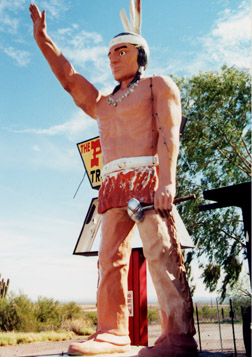A cultural critic and professor of English talks about roadside Indian kitsch and tells us what it means. (Nothing good, obviously.)
Southwest Semiotics: Native American Roadside TextsBy Dean Rader (The Weekly Rader)The main iconography of the Southwest's myth--for better or worse--is all things Indian. On one hand, the pervasiveness of Indian imagery reminds Americans passing through Native lands that Indians are still here. They are alive, well, and doing just fine. On the other hand, the stereotyping--especially among roadside statues and sculptures--continues to rankle.
For example, the Chief above giving the "Howe" greeting looms out front of Howe Chevrolet in Clinton, Oklahoma, just off of Route 66 and Interstate 40. It's been there for as long as I can remember, and it stands as the car dealership's main visual cue. But, it also reminds too much of the painful cigar store Indian, which (even if not intentional) evokes images of the stoic, "wooden," passive, and defeatable Indian.And:
The sign and statue to the left stands outside the Cherokee Restaurant and Trading Post near Hinton, Oklahoma. This guy, too, seems a bit stiff, but at least he is armed for battle. I'm not at all convinced he's wearing traditional Cherokee clothes, and again, he's bare-chested. I'm still waiting to see a statue of an Indian holding a book, looking through a microscope, sitting in a stately chair, or holding hands with a white woman. The problem with images like these is their reductiveness--it limits how we see Indians. We think we're smart enough not to equate these images with true Indianness, but if these are the only representations of Indians most Americans see, aside from the Land O' Lakes gal and the American Spirit tobacco guy and the Washington Redskins mascot and the Atlanta Braves mascot and the Florida State Seminoles mascot ... well, you get the idea ....Comment: Actually, the Cherokee statue isn't bare-chested. Don't mistake his reddish shirt for his grayish skin.
Rader also mentions "The Guardian" statue atop the Oklahoma State Capitol. For my comments on that, go to the end of the
original posting.
Below: A typical "Indian" of this type. Someone may be mass-producing these Indian icons, because it looks a lot like the Howe Chevrolet statue.



No comments:
Post a Comment
Note: Only a member of this blog may post a comment.